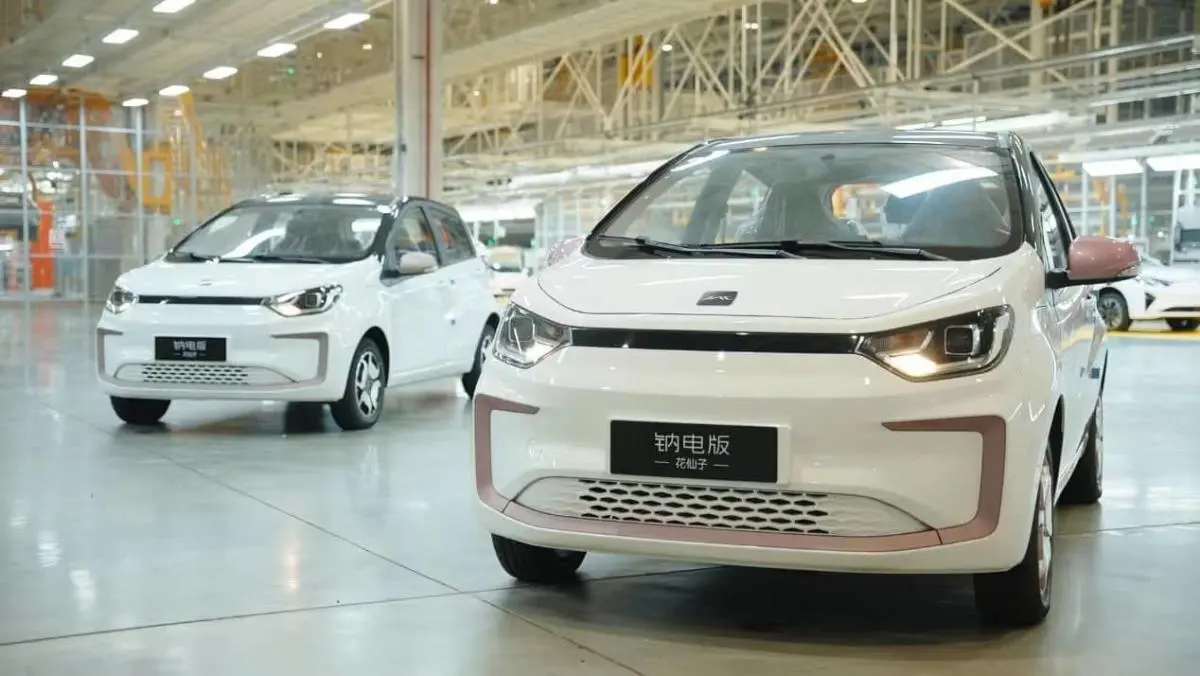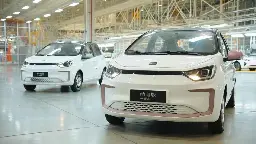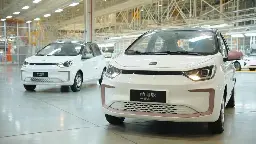The first EV with a lithium-free sodium battery hits the road in January
The first EV with a lithium-free sodium battery hits the road in January

The first EV with a lithium-free sodium battery hits the road in January

The first EV with a lithium-free sodium battery hits the road in January

The first EV with a lithium-free sodium battery hits the road in January

This is awesome news. Not because of the car, but because it builds the supply lines for an alternative battery chemistry.
People have been using lithium-ion batteries for home and grid storage, which is nuts if you compare it to other battery types. Lithium is expensive and polluting and only makes sense if you're limited by weight & space. Cheaper batteries, even if they're bigger/heavier, will do wonders to the economics of sustainable electricity production.
People have been using lithium-ion batteries for home and grid storage, which is nuts if you compare it to other battery types
Compared to other battery chemistry types using lithium makes tons of sense.
Lead acid type batteries like sealed and AGM are cheap but not power dense and do not offer the same discharge ability that lithium offers without damaging the battery (AGM fixes this but it's still an issue). Some lead acid batteries require continuous maintenance and vent toxic gasses which may be an issue depending on your encloser.
Nickel cadmium batteries solve a lot of issues that lead acid batteries are plagued with however they suffer from moisture intrusion issues causing self discharge. Nickel cadmium also suffers from memory effect which may completely ruin pour battery depending on your use. The elephant in the room with nickel cadmium is that it's banned in some countries including the European union due to how toxic cadmium is.
Now with lithium, it's a very energy dense battery which means you need less batteries to meet a capacity or you can fit more capacity into an encloser. There isn't any electrolyte or water maintenance you need to worry about. You can discharge and recharge as you wish with minimal damage. Really the only downsides is that they do not like charging in the cold, are just as toxic as cadmium, and are much much much more expensive.
I find it interesting that, on a post about sodium ion batteries, your comment completely excludes them
I agree that older commercialized battery types aren't so interesting, but my point was about all the battery types that haven't had enough R&D yet to be commercially mass-produced.
Power grids don't care much about density - they can build batteries where land is cheap, and for fire control they need to artificially space out higher-density batteries anyway. There are heaps of known chemistries that might be cheaper per unit stored (molten salt batteries, flow batteries, and solid state batteries based on cheaper metals), but many only make sense for energy grid applications because they're too big/heavy for anything portable.
I'm saying it's nuts that lithium ion is being used for cases where energy density isn't important. It's a bit like using bottled water on a farm because you don't want to pay to get the nearby river water tested. It's great that sodium ion could bring new economics to grid energy storage, but weird that the only reason it got developed in the first place was for a completely different industry.
Now with lithium.... are much much much more expensive
and explosive
Really the only downsides is that they do not like charging in the cold, are just as toxic as cadmium, and are much much much more expensive.
Seems like some pretty big and numerous downsides lmao
*enclosure
Don't forget the volatility of Lithium batteries if they ever get damaged or punctured.
What about nickle-metal hydride?
Lithium makes more sense when weight is an issue, for example when you have to carry the battery around. Sodium batteries could be good for grid storage if they can be implemented as scale cheaply enough, especially using common materials.
A quick wikipedia read implies that sodium-ion batteries could be half or less the cost vs lithium. Also this:
Another factor is that cobalt, copper and nickel are not required for many types of sodium-ion batteries, and more abundant iron-based materials work well in Na+ batteries.
That's probably most of why it's cheaper, and it's also way less damaging to the environment if they truly can be made from mostly sodium and iron.
I'm more concerned about the safety aspects. It seems there are two main types:
That's a big reason why I and probably many others aren't interested in the current batch of EVs. Yeah they're pretty safe, but they're quite violent when they fail. I'd probably buy a sodium-ion EV if it could get 100-150 miles range reliably. That would be absolutely sufficient for my commute, even in the winter, and it would make a fantastic "around town" car when I'm not working.
Not just that, we don’t have enough lithium deposits atm to build enough lithium evs to last more than a few decades if we act smart (which we generally do not).
Cheaper batteries, even if they're bigger/heavier
Yes, just what we need is more vehicles on the road that weigh as much as a tank but accelerate like a Ferrari. I'm sure that won't cause any problems.
That is the case with every energy storage though in some cases it's more pronounced.
We've only got a stated range out of this (252km/157mi) but there are a lot of factors where this could do well. Sodium batteries should be cheaper, so it'd be great if that translated to the final sale price. Depending on charge times and where you live, this could be a perfectly practical vehicle. If it doesn't degrade like lithium batteries, then that'd be even better. Might make for a great secondary vehicle (or everyday driver, depending).
I'm expecting to see dual battery EVs in the not too distant future. A Sodium battery for the primary that gets the most charges and discharges which can be easy and cheaper to replace. Beside that a Lithium battery which would only be drawn from after the Sodium battery was exhausted. This way if you're doing shallow discharges for your "around town" driving then charging at night, and deep discharges for longer road trips where the energy density of Lithium shines.
Lithium batteries dont like being stored fully charged they will degrade over time.
I'm still dreaming of seeing EVs with flexible battery space, which users can fill according to their needs.
Like a car comes with space for 10x 10 kWh slots.
If 20 kWh serve your usual needs, the other spaces remain empty.
And if you plan longer trips and don't want to recharge each 100 miles, you put in additional batteries. Those batteries don't need to be owned, but can be rented.
Ideally there are lots of battery rental stations, where you can get charged batteries and instead of recharging the batteries in the EV, the rent'n'swap stations recharge them.
During (EV) wise low use times, these stations can provide a buffer to the energy grid.
...one can dream...
Interesting idea. I hadn't thought of that possibility!
The other thing is that it could also potentially be significantly cheaper to replace if it wears out. And could potentially be easier to recycle too, if it's common salts. I'm optimistic about it!
That's a perfect range for me. If it's relatively cheap and charges reasonably well in the winter, I'll buy it.
We currently have two cars:
A lot of my neighbors have a similar setup because either one person doesn't work or works at home, but they often need to use both cars simultaneously. If it's priced well, it'll sell well.
The main problem with existing EVs are that they either have far too little range (e.g. original Leaf w/ 70 miles range), or are way too expensive because they try to get too much range (200+ mile range). That higher range is kind of necessary because of degradation, whereas if the battery were cheaper to replace, more people would be willing to buy something with lower range and replace the battery after a few years.
252km is 3 days worth of commuting for many people I know. For me personally it is one and hald days of work, moving around in a diesel beast. I would go stupid giddy if I was handed one of these for a daily work driver
Question to anyone who might know more: would sodium based batteries be better than lithium ones for the environment, in terms of recycling or disposing of it?
In case they are indeed better, would they be better because it's better to use less lithium in general (so if you use more sodium based ones, you use less lithium) or would they be also better because their own disposal is "nicer" (as in less toxic) for the environment?
Well, Sodium is the 6th most abundant element on Earth, so there's a lot more of it and the extraction process is probably far more environmentally friendly.
Since Sodium batteries are so new I don't think we have data on the toxicity, disposal or recycling avenues yet.
They're actually old tech. They just could never match lithium.
They'll shine as standing storage more so than mobile applications. Home storage will benefit greatly from their improvements
Interesting! So it would make sense to have tons of sodium batteries for all purposes for which one doesn't need maybe higher capacity or performance as I understand lithium batteries offer
I don't find the source anymore, but i saw a lifetime analysis about sodium ion batteries. Overall they are slighly worse than lithium ion due to higher energy input required during fabrication, despite better mineral availability.
The most common Na-ion batteries use Prussian Blue.
I suppose maybe they're still useful innovations if they can be made with minerals which are more available.
Probably, we could achieve a balance between one type and the other, but I'm daydreaming now...
The main idea here is that we won’t run out of raw materials very easily when using stuff that’s relatively cheap and abundant. Well at least the ions are. Who knows what the anode and cathode are made of. Probably the usual materials; otherwise they would have mentioned it. If they still use cobalt in the cathode, you can’t really avoid the ethical questions that come with it.
Producing all the other materials can be rather energy intensive depending on the method used, so it depends. If you buy your metals from a country with hardly any environmental regulation, you can be pretty sure they don’t give a dingo’s kidney as to how many trees are chopped down and how many puppies are thrown in a furnace to get the next shipment of metals delivered.
Also, the electrolyte could be more or less harmful to humans and the environment. As far as the environmental impact is concerned, these batteries probably come with all the usual issues. Currently there just aren’t any perfect solutions commercially available. Regardless, this seems like a step in the right direction IMO.
My doctor says I can't buy it. Is there a low sodium version?
Sooo... It's a salt truck?
It's a salt in battery
Volkswagen: Stop hitting yourself.. Stop hitting yourself.
But you can't stop hitting youraelf because Volkswagen has you by the wrists and is usng them to make you hit yourself with your own hands over, and over again.
as much as any other electric vehicle out there
Unfortunately the page is behind the yahoo consent tracker and my DNS resolver by precaution refused to connect.
Inline-js and third-party js disabled loads the page without any consent.
These ones look pretty normal to me. I think there are a few options now that look like regular cars. The only difference usually is they don't have a front grill because they don't need one.
Yeah, my guess is that it's the lack of a front grill that makes them look goofy to people. You'll get used to it.
What are you on about lol, this literally looks like a normal subcompact car.
VW up in production since 2011 https://en.m.wikipedia.org/wiki/Volkswagen_Up
Skoda citigo
https://webapps.skoda-auto.sk/Cenniky-a-katalogy/cenniky/Skoda_Citigo_cennik.pdf
Here's the summary for the wikipedia article you mentioned in your comment:
The Volkswagen Up (stylized as Volkswagen up!) is a city car produced by the Volkswagen Group since 2011. It was unveiled at the 2011 International Motor Show Germany (IAA). Production of the Up started in December 2011 at the Volkswagen Plant in Bratislava, Slovakia. It is part of the part of the New Small Family (NSF) series of models, alongside the SEAT Mii and Škoda Citigo which are rebadged versions of the Up, with slightly different front and rear fascias. The SEAT and Škoda versions were manufactured in the same factory, before being withdrawn from sale in 2021 and 2020 respectively. Production of the Up ended in October 2023. A battery electric version, called E-up, was launched in autumn 2013.
Have a look at the Cupra Born, looks awesome and is a great car. Already 18 months old as a design.
Agreed, just give me Jeep Cherokee/Wagoneer and id be happy. Bonus if it has the same interior and no shitty tracking bs.
They don't need a a front opening to the radiator, that might be why you find them strange.
E-berlingo looks exactly the same as normal Berlingo. Since it's a fairly new design I'm guessing they had both versions in mind when designing the ICE one.
Wait how is this the first? Didn't the th!nk city have a molten sodium battery years ago?
First sodium-ion battery powered cars. Different tech.
yes it was a sodium battery, but it had different chemistry. This one does not need to be molten to work!
Where is the sodium coming from?
My diet, probably
Low blood pressure gang unite 🤜
Stars probably
It comes from stars.
Stardust.
Any new battery technology news needs to be taken with a grain of salt. They are highly likely over-hyped and the actually realized products will have more problems than the current established tech initially.
Any new battery technology news needs to be taken with grain of salt.
Well yeah, it's sodium.
Normally you're right. It seems like every day there is a new revolutionary battery tech with no real estimate when it'll ever be in use. But in this case, according to the article, deliveries will start next month which means they're already in production.
Before clicking I knew it would be Chinese


'252 km (157 miles) range' to save others the same skimming I did
Not bad for that battery's first outing
Perfect for my needs. But I doubt it will ever be for sale here in the U.S.
I've found people vastly overstated how much range they need. 99% of usage is in the city between home and somewhere else. 250km is perfect if the price is right.
For daily use, sure - but it completely excludes itself as an option for road trips in the US and parts of Canada. There's a stretch of interstate road near me with nearly a 100 mile gap between service stations.
I know that this isn't the purpose of this battery, but it's a valid reason why a lot of people might be hesitant to buy one. Many people can't afford multiple vehicles for different purposes. You have the car you drive to work with, and if you happen to go on a trip you just use the same thing.
Maybe 99% of use occurs within constraints that this battery can handle, but if you can only afford one vehicle, then this is still a pretty suboptimal option. That being said... it could still be cheap enough to not matter. I didn't see any mention of price in that article.
Exactly. We have two cars, and we only need one to have any kind of range. The other is fine with 250km/150mi range, but it needs to be relatively inexpensive to buy and repair. It'll just be for a daily commute and around-town driving, no expectation for long-distance.
It doesn't need space for people or stuff, just 2-4 passengers is plenty. It'll strictly be for commutes and small trips to the grocery store and whatnot, the other car can be used for larger trips.
Id like to add that there are different versions of the car, with the long range version being 302km range, and the battery mass to energy ratio is actually average compared to other batteries.
Also, those ranges are for the sehol branded version, the car in the article might have a different range(although I doubt it) https://www.batterydesign.net/sehol-e10x-sodium-ion/
Wow that sounds very useable
That's not bad if the price is right.
I'd be willing to buy one for ~$5-8k.
5-8k for a car in this day and age? That's the price of a scooter
Lol
I'd pay $15-20, depending on how well it worked.
Perfectly usable for urban travel in Chinese cities
And recharging times?